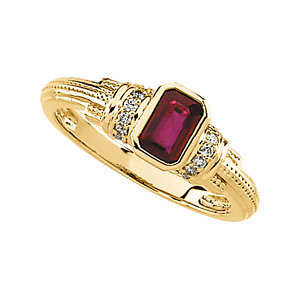RUBY
Ruby is July’s birthstone, and the gemstone of 15th and 40th anniversaries.
About Rubies
Rubies are the most valuable colored gemstone on the market today. They capture the color of our most powerful emotions, passion and anger. Rubies have often been referenced with their similarity in color to blood, and often believed to have held the power of life.
A ruby is made primarily the mineral corundum, colored with a hint of chromium. High value ruby’s will fluoresce, or become more brilliant in sunlight. Often this glow was associated with an internal fire in the stone, making it more valuable. Some of the most valuable ruby’s form in marble, although ruby’s are also found in basalt.
Folklore of Rubies
Hindus believed someone possessing a fine ruby, had the advantage of perfect safety. In ancient India, it was believed that possessing ruby’s allowed you to live in peace with your enemy’s. The history of Burma, accounts warriors inserting ruby under their skin to make them invincible in battle.
History of Rubies
The name Ruby is derived from the Latin word ‘Ruber’ meaning red.
Rubies have had a long place in history, in the bible they are mentioned four times, associated with wisdom and beauty. When ruby or ‘ratnaraj’ is translated from Sanskrit, its meaning is ‘king of gemstones’.
Ruby Care
Rubies are for the most part quite stable for everyday wear. Some rubies available today, with surface reaching fractures, have been treated with a high lead glass to fill small natural cavities. Treated rubies require extra care. Mild acids such as lemon juice may etch the treatment.
Warm soapy water is always your safest option. Use a damp cloth and baby toothbrush to gently clean all surfaces. Untreated rubies may be safely cleaned in an ultrasonic or steam cleaner.

